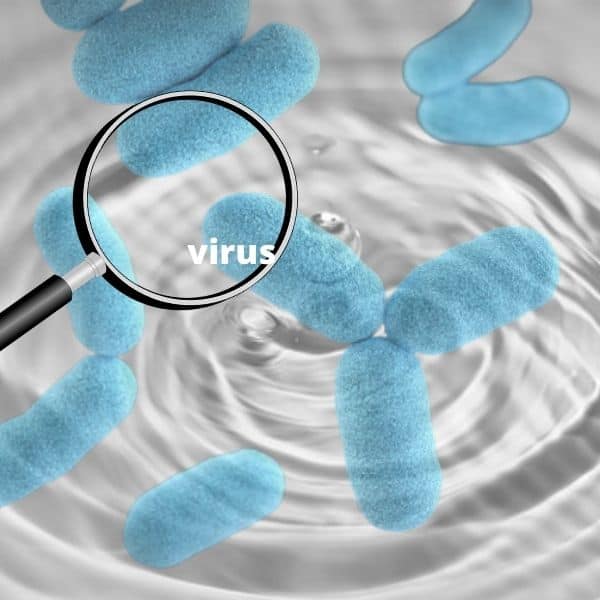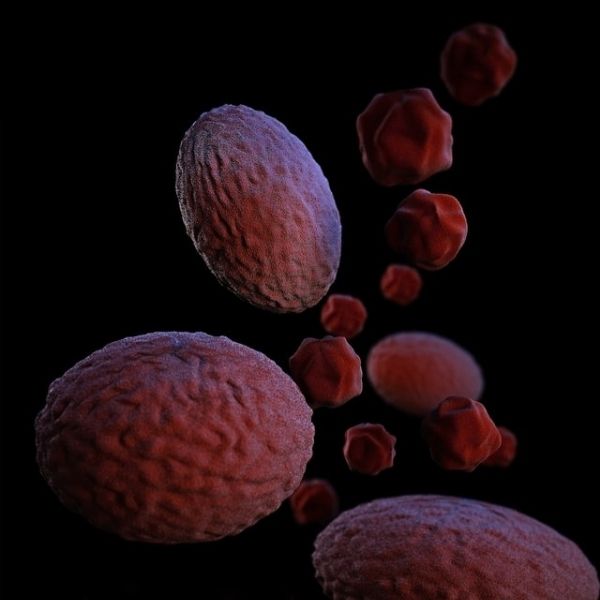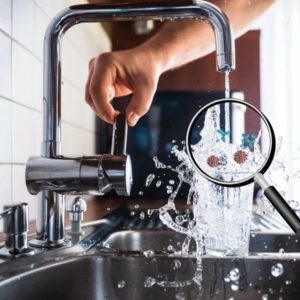Effective Ways of Removing Viruses From Drinking Water
It is comparatively easy to remove viruses from water than any other contaminant. The most effective ways to remove viruses are:
Chlorination
It is one of the most popular chemical disinfection and treatment methods for water due to its cheap cost. This is the reason why you always smell the Chlorine from your pool water. According to the World health organization (WHO) Chlorine in small amounts is safe for drinking. That’s why it is used for the removal of viruses from water.
Chlorine removes viruses through a chemical reaction. When Chlorine is mixed with water, a weaker acid called hypochlorous acid is formed, dissolving virus and bacterium cells and killing them from inside.
It may leave a synthetic odor in your water. If this is an issue for you, an activated carbon filter can quickly help you improve your water’s smell and taste.
Ozone Water Treatment
Through oxidation, ozone water treatment eliminates viruses and other harmful pollutants from your water. One of nature’s most active oxidizing agents is ozone (O3), an oxygen molecule. Ozone is initially manufactured in an ozone generator before taking part in water treatment. It’s then mixed with water, oxidizing organic matter in the virus.
Their cells get weaker, split, and die due to this reaction. The best part about this process is that it’s quick and can purify water in seconds.
Boiling
You can filter water yourself with this easy method. Rolling boil the water for at least one minute is an important technique. Because their molecules are dissolved, this continuous, intense heat is enough to kill not just viruses but bacteria, protozoa, and other pathogens making it an effective pathogen reduction method.
Keep your boiling water chilled in the refrigerator until you need it. Heating does not eliminate chemical poisons or other pollutants, such as toxic substances or soil.
Distillation Systems
It is another effective method to purify water. Distillation systems work by raising the water temperature to its boiling point and then gathering the water vapors, leaving several contaminants and viruses.
Distillation methods are mainly used to remove pathogens such as Cryptosporidium and Giardia. Viruses such as enteric, Hepatitis, norovirus, and rotavirus are easily removed using distillation systems.
What Are Viruses In Water?

Viruses are microscopic germs that enter the water through various sources, spreading diseases and making it unsafe to drink. Although virus in the water supply may threaten human health, it is still less harmful than some other pollutants and contaminants.
Still, it is dangerous, so it should be appropriately removed and filtered before consuming the water. Viruses can be found in almost all water sources like well-water, river water, or tap water. Various methods are then used to disinfect water. Water PH also plays an important role in the disinfection process
Sources of Water Contamination
Viruses enter the water when polluted by a sick human or animal’s urine or feces. Floods, dirty stormwater runoff, and a malfunctioning sewer system add danger. Well-water and water from non-sterilized sources like rivers and lakes are highly prone to contamination.
In reality, all unprocessed water sources are vulnerable to virus infection, and many emerging economies are troubled by virus outbreaks due to a lack of safe drinking water. According to US environmental protection agency (EPA), the rising population is another big reason for the declining water quality around the globe.
Water in rivers is also contaminated with viruses because of animal feces. So, if you are going on a hike take a filter water bottle or some other kind of filter with you.
Symptoms and Dangers of Virus in Water

It is impossible to detect viruses in water by just tasting them. So, laboratory tests are required to see them. Here are some of the diseases that viruses in water can cause:
Hepatitis
There are several types of waterborne viruses including Hepatitis, and all the types directly target the liver and damage it. On the other hand, hepatitis A and E are the only two viruses that may transmit through polluted water. Fever, tiredness, lack of appetite, vomiting, and jaundice are signs of Hepatitis A and E.
RotaVirus
Vomiting, Diarrhea, lack of appetite, and dehydration are the most common symptoms of rotavirus in newborns and young children. Adults can also develop rotavirus, although the symptoms are generally weaker.
There are two Rotavirus vaccinations available for newborns, but none for older children or grown-ups.
Norovirus
Norovirus is also one of the waterborne pathogens that spread quickly because only a few virus particles are required to make a human sick. Diarrhea, vomiting, headache, and stomach pain are all common symptoms. Norovirus is challenging to control because it may spread outside of drinking purposes. You might get ill if food is cultivated or produced with polluted water.
Does Water Filter Remove Viruses?
Before consumption, water is regularly filtered, but have you wondered what is processed out? Is it true that filtering alone removes waterborne viruses, germs, and other pollutants, making drinking water safe? It’s something to think about, especially if you’re getting your drinking water from a natural source.
Viruses are far too tiny to be caught by a typical filtration system. Most mechanical filters will eliminate micron-sized pollutants, but viruses are just nanometers (1-100 nm) in size and will go across.
It does not mean that you can’t eliminate viruses; our point is that you should choose a water filter specifically for virus removal.
Which Water Filters Remove Viruses?
Filtering out viruses isn’t as easy as eliminating other contaminants. Therefore, it is essential to know which filters remove viruses; the list contains:
Reverse Osmosis System
The reverse osmosis system is the most common purification method to remove viruses and other pollutants from the water. The pore size of the reverse osmosis system is 0.0001 microns which makes it ideal for filtering out the light virus particles and germs.
Reverse osmosis systems are pretty effective in removing bacteria as well as viruses and other pathogens.
Ultrafiltration and Nanofilteration
An ultrafiltration process pushes water through a perforated fiber membrane that catches viruses using normal domestic water pressure. Only pure water and minerals are allowed to pass across.
Most filters can’t stop viruses because they’re too thin, but an ultrafiltration membrane is roughly 0.025 microns thick, whereas viruses are around 0.1 microns thick. They are effective to remove some other living organisms too but do not filter out any organic material.
The typical human hair is 70 microns in diameter, so you can imagine how tiny they are!
Backpacking Filter
As its name suggests, this is a type of filter that can accompany you to clean your water while you are outside for camping or hiking.
As we all know, river water is the main source of water when we are on a camp, and this water can contain viruses or pathogens. It is generally called a hiking water filter because it is the first choice of hikers and those who frequently go for outdoor activities.
A backpacking filter will help you purify the water within seconds and then you are good to go for enjoying the moment. The best part about this filter is that you don’t have to carry a bottle along because this filter also acts as a straw bottle.
Ultraviolet (UV) Purification Filters
With the advancement of science and technology, we can see UV technology in water treatment. UV filter attacks the DNA of viruses and destabilizes them. By this process, the virus cannot reproduce or split further and then completely stops.
Ultraviolet light and a purification system can eliminate almost 99% of virus DNA from your water leaving you with all healthy water.
FAQ’s on Removing Viruses From Drinking Water
How do I know if my house water is contaminated with viruses?
The only way to find out is to buy a water TDS water quality checker if you want to check your water at home. But, you can also take it for a laboratory test and know exactly what the situation is with your water.
Does Water softener remove Viruses?
No, the water softeners can’t remove viruses. Water softeners are mainly used for the removal of hardness while viruses are a type of pathogens and germs.
Does Boiling Water Kill Viruses?
Yes, boiling water is an excellent method used for killing viruses. Heat your water to the boiling point for one minute or three minutes if you live in cold or snowy areas. It can eliminate almost 99% of viruses from your drinking water.
Final Words
Viruses in a home’s water supply can be deadly. That’s why we thought to educate everyone about it through our platform. We sincerely hope that you enjoyed every second you spent reading what we wrote. If there is still something left that you think is important, do let us know in the comments below.
Share this information with your friends and loved ones to educate them too.
